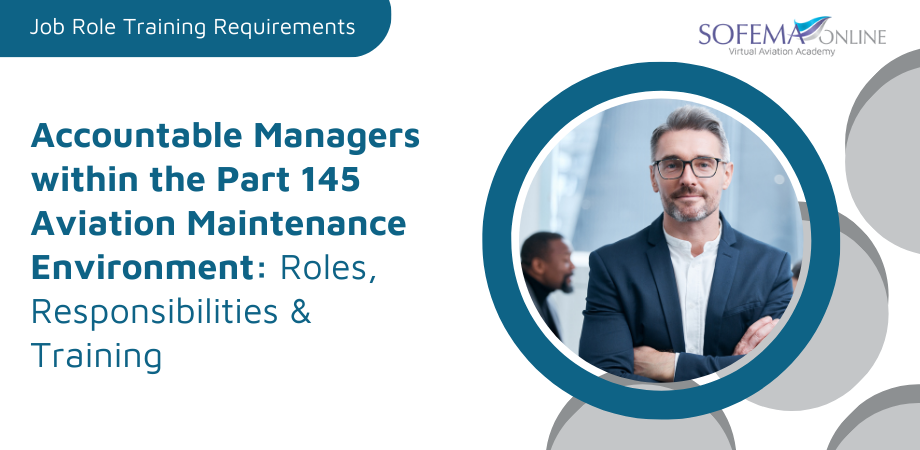The EASA Accountable Manager (AM) in an aviation maintenance and manufacturing organization holds a pivotal role, being ultimately responsible for ensuring that all activities are conducted in accordance with the applicable regulations and standards.
The specific duties of an Accountable Manager can vary depending on the size and type of the aviation maintenance organization, as well as the jurisdiction in which it operates. It’s important to note that while the Accountable Manager may delegate tasks and responsibilities to other staff members, the ultimate responsibility for the operation’s compliance and safety rests with the AM.
The following attributes will be found in a competent Accountable Manager (AM)
- Holds a deep understanding of the obligations and expectations of an EASA Part 145 Accountable Manager (AM)
- Develops a focus on Management System requirements with Safety and Compliance Management techniques required in EASA Part 145A.30
- Understands the relationship between the Quality Management System (QMS) and Safety Management System (SMS)
Here’s an overview of the typical roles and responsibilities of an Accountable Manager in Aviation:
> Regulatory Compliance:
Ensuring that all operations are conducted in compliance with the relevant aviation regulations and standards.
- Maintaining an effective Safety Management System (SMS).
> Safety and Quality:
Overseeing the implementation of the SMS and promoting a safety culture within the organization.
- Ensuring that the company has all the necessary resources to maintain the highest safety standards.
- Making sure that all operations are performed to the standards required by the regulator and customer airlines.
> Financial Oversight:
Managing the financial health of the operation, including budgeting and cost control.
- Ensuring that there are enough financial resources to operate safely and efficiently.
> Personnel Management:
Ensuring that all staff are properly trained and qualified for their roles.
- Making sure that there are enough personnel to meet the operational needs.
> Operational Control:
Having ultimate responsibility for all aspects of the operational control of the airline.
- Ensuring that all operational procedures are documented and adhered to.
> Liaison with Regulatory Bodies:
Acting as the main point of contact between the aviation company and the regulatory authorities.
- Ensuring that all required documentation, certifications, and records are up-to-date and available for inspection.
> Continuous Improvement:
Promoting continuous improvement within the organization.
- Ensuring that feedback from audits, incidents, and other sources is used to improve operations.
> Corporate Governance:
Upholding corporate governance standards and ensuring that the organization meets its legal and ethical obligations.
- Reporting to the board of directors or the ownership structure of the organization on the performance and challenges of the operation.
> Communication:
Ensuring effective communication within the organization and with external parties.
- Making decisions on matters of policy, strategy, and operations.
> Emergency Response Planning:
Ensuring that there is an effective emergency response plan in place and that staff are trained to respond to emergencies.
> Organizational Training Needs
Oversight of 145 Organizational Initial, Recurrent, and Vocational Regulatory Training Requirements.
- Ensuring that the organization meets or exceeds its regulatory training obligations.
Online Training Availability
Consider the following Online Training Program specifically developed for Operational Accountable Managers:
Accountable Manager and Post Holder (NP) 145 Organisation Regulatory Training Program
It consists of Core Regulatory Obligations Training to provide familiarization as required by EASA and European Regulatory Authorities. This program is fundamentally aimed at Accountable Executives who have specific obligations regarding the accountability of the organization to meet its obligations with respect to Safety, Quality, Regulatory Compliance, and Financial well-being.
Consider the following courses, which are recommended as a minimum to support the Accountable Manager role:
- Accountable Manager and Post Holder (Nominated Persons) Core Regulatory Obligations training
This course considers in detail the Role and Responsibilities of both Accountable Managers as well as Aviation Post Holders to understand their responsibilities to ensure compliance with EASA regulations. - Part 145 Foundation with VO
The course aims to provide delegates with a detailed practical understanding of EASA Regulations relevant to the Part 145 environment as well as an overview of all parts of EASA Part 145 to provide a comprehensive understanding of the role of EASA Part 145 and how it interfaces with Part M. - EASA Quality Assurance Auditing Foundation
This course provides an ideal introduction for those wishing to have a detailed understanding of an EASA-compliant Aviation Quality System, to understand how Quality Assurance should be positioned at the heart of the operation, fully functioning within every department and element of the organisation. - Aviation SMS Foundation with VO
This course delivers one of the best fundamental SMS introductions available. Building on the importance for all members of the organisation to be able to engage with the SMS. - Quality & Safety Root Cause Analysis within an EASA Environment Foundation
This course considers the process of assessment related to Risk-based competencies and Root Course Analysis Techniques throughout the industry and focuses on the needs of the aviation professional to understand root causes and to be able to respond in an effective way to audit findings.
Read about more Aviation Job Role Training Requirements, Roles, and Responsibilities on this page
Tags:
Quality Management System, Safety Management System, EASA Quality Assurance Auditing, Aviation SMS, SOL Training, Aviation Regulations, Job Role Training Requirements, EASA Accountable Manager, Part 145 Aviation Maintenance Environment, EASA Part 145A.30, Regulatory Training Program, Root Course Analysis Techniques





